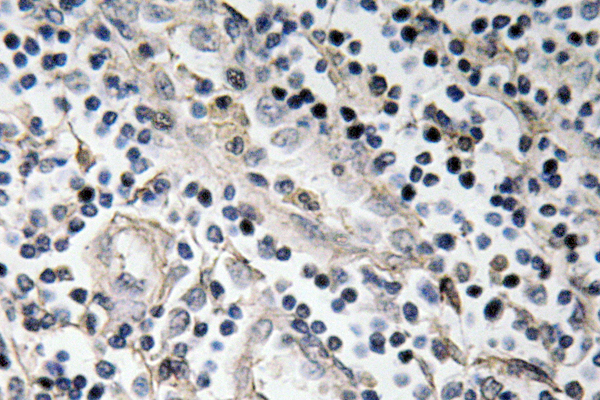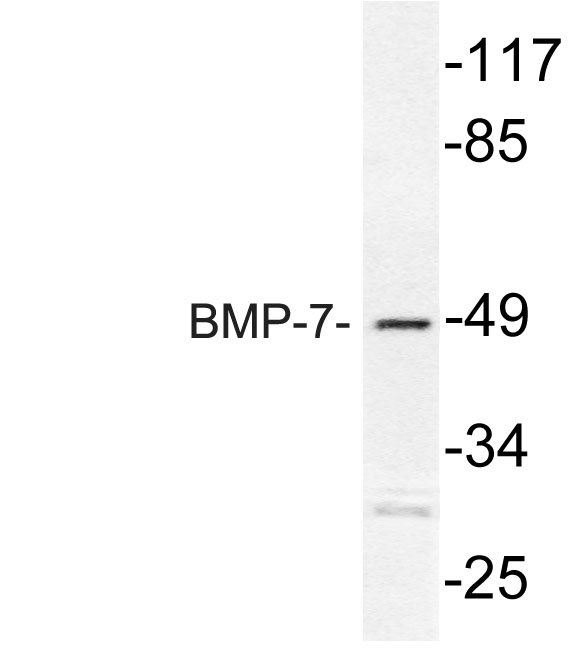BMP-7 Polyclonal Antibody
- Catalog No.:YT0503
- Applications:WB;IHC;IF;ELISA
- Reactivity:Human;Mouse;Rat
- Target:
- BMP-7
- Fields:
- >>Cytokine-cytokine receptor interaction;>>TGF-beta signaling pathway;>>Axon guidance;>>Hippo signaling pathway
- Gene Name:
- BMP7
- Protein Name:
- Bone morphogenetic protein 7
- Human Gene Id:
- 655
- Human Swiss Prot No:
- P18075
- Mouse Gene Id:
- 12162
- Mouse Swiss Prot No:
- P23359
- Immunogen:
- The antiserum was produced against synthesized peptide derived from human BMP-7. AA range:124-173
- Specificity:
- BMP-7 Polyclonal Antibody detects endogenous levels of BMP-7 protein.
- Formulation:
- Liquid in PBS containing 50% glycerol, 0.5% BSA and 0.02% sodium azide.
- Source:
- Polyclonal, Rabbit,IgG
- Dilution:
- WB 1:500 - 1:2000. IHC 1:100 - 1:300. ELISA: 1:40000.. IF 1:50-200
- Purification:
- The antibody was affinity-purified from rabbit antiserum by affinity-chromatography using epitope-specific immunogen.
- Concentration:
- 1 mg/ml
- Storage Stability:
- -15°C to -25°C/1 year(Do not lower than -25°C)
- Other Name:
- BMP7;OP1;Bone morphogenetic protein 7;BMP-7;Osteogenic protein 1;OP-1;Eptotermin alfa
- Observed Band(KD):
- 55kD
- Background:
- This gene encodes a secreted ligand of the TGF-beta (transforming growth factor-beta) superfamily of proteins. Ligands of this family bind various TGF-beta receptors leading to recruitment and activation of SMAD family transcription factors that regulate gene expression. The encoded preproprotein is proteolytically processed to generate each subunit of the disulfide-linked homodimer, which plays a role in bone, kidney and brown adipose tissue development. Additionally, this protein induces ectopic bone formation and may promote fracture healing in human patients. [provided by RefSeq, Jul 2016],
- Function:
- function:Induces cartilage and bone formation. May be the osteoinductive factor responsible for the phenomenon of epithelial osteogenesis. Plays a role in calcium regulation and bone homeostasis.,online information:Bone morphogenetic protein 7 entry,pharmaceutical:Available under the names Osigraft (Stryker). Its use is indicated in the treatment of tibial non-union of at least 9 month duration, secondary to trauma, in skeletally mature patients, in cases where autograft has failed or is unfeasible.,PTM:Several N-termini starting at positions 293, 300, 315 and 316 have been identified by direct sequencing resulting in secretion of different mature forms (PubMed:17977014).,similarity:Belongs to the TGF-beta family.,subunit:Homodimer; disulfide-linked. Interacts with SOSTDC1. Interacts with TWSG1.,tissue specificity:Expressed in the kidneys and bladder. Lower levels seen in the brain.,
- Subcellular Location:
- Secreted.
- Expression:
- Expressed in the kidney and bladder. Lower levels seen in the brain.
- June 19-2018
- WESTERN IMMUNOBLOTTING PROTOCOL
- June 19-2018
- IMMUNOHISTOCHEMISTRY-PARAFFIN PROTOCOL
- June 19-2018
- IMMUNOFLUORESCENCE PROTOCOL
- September 08-2020
- FLOW-CYTOMEYRT-PROTOCOL
- May 20-2022
- Cell-Based ELISA│解您多样本WB检测之困扰
- July 13-2018
- CELL-BASED-ELISA-PROTOCOL-FOR-ACETYL-PROTEIN
- July 13-2018
- CELL-BASED-ELISA-PROTOCOL-FOR-PHOSPHO-PROTEIN
- July 13-2018
- Antibody-FAQs
- Products Images

- Western Blot analysis of various cells using BMP-7 Polyclonal Antibody diluted at 1:500
.jpg)
- Western Blot analysis of rat-musle cells using BMP-7 Polyclonal Antibody diluted at 1:500

- Immunohistochemistry analysis of BMP-7 antibody in paraffin-embedded human tonsil tissue.

- Western blot analysis of lysate from Jurkat cells, using BMP-7 antibody.



